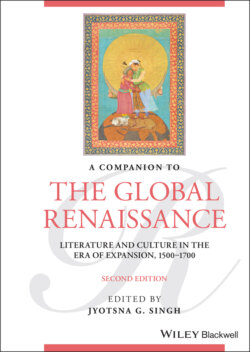Читать книгу A Companion to the Global Renaissance - Группа авторов - Страница 24
NOTES
Оглавление1 1 The Armada portrait is frequently ascribed to George Gower, the Queen’s Sergeant–Painter, but Karen Hearn questions this certainty: “Apart from the portrait miniatures of the Queen, principally by Nicholas Hilliard, it is almost impossible to identify the actual artists who painted the portraits that have survived. A draft patent drawn up in 1584 would have given Gower a monopoly of her image in every format in large … Yet no extant portraits can with certainty be ascribed to Gower himself” (77). For a fuller account of Elizabethan portraits, see Karen Hearn, Dynasties: Painting in Tudor and Jacobean England, 1530–1630 (77–116). Leah Marcus, like several other critics, accepts the attribution to George Gower in Puzzling Shakespeares: Local Reading and its Discontents (279).
2 2 See Hearn (88). Also, given that there are different dates ascribed to the portrait, general references to the English child in Virginia being born “just before this portrait was created” do not indicate a specific date. For a popular view, see the following website: http://tudordynasty.blogspot.com, accessed January 4, 2020.
3 3 Jerry Brotton, “Terrestrial Globalism: Mapping the Globe in Early Modern Europe,” in Denis Cosgrove, ed., Mappings (71). Also, see Anthony Grafton and Lisa Jardine, “How Gabriel Harvey Read His Livy” (Past and Present 129: 30–78). Brotton, in “Terrestrial Globalism” (87), citing the aforementioned article, observes that terrestrial globes were not “simply regarded with the passive curiosity that characterizes connoisseurship … [t]hey were rather, in the words of Lisa Jardine and Anthony Grafton, ‘studied for action’ by scholars, princes, and diplomats who invested so much political power and authority in them.”
4 4 I loosely adapt this term taken from Arjun Appadurai’s formulation of a contemporary global cultural economy that consists of “imagined worlds” within a “complex, overlapping, disjunctive order, which cannot any longer be understood in terms of existing center-periphery models,” in Modernity at Large: Cultural Dimensions of Globalization (32–33). He is countering the colonial and neocolonial paradigms of margin and center at the height of empire and later; the early modern global networks, I believe, are also complex and shifting in an age of cross–cultural discoveries and emergent power struggles.
5 5 For a description of the ideological underpinnings of Burckhardt’s idea of the “Renaissance Man,” also see Brotton, The Renaissance Bazaar: From the Silk Road to Michelangelo (22–27).
6 6 For a full discussion of Renaissance Imitatio, see Greene’s definition in The Light in Troy: “Imitatio was a literary technique that was also a pedagogic method … it contained implications for the theory of style, the philosophy of history, and for conceptions of the self” (2). Also see Brotton, for the ways in which a humanist education became useful in “understanding the economics of a progressively global Renaissance world picture,” in The Renaissance Bazaar: From the Silk Road to Michelangelo (11).
7 7 For a fuller account of Arabic learning in the field of mathematics and its influence on Western modes of knowledge and commercial practices, see Patricia Parker’s essay, “Cassio, Cash, and the ‘Infidel O’: Double-entry Bookkeeping and Othello’s unfaithful Accounts.” Also see Brotton, Renaissance Bazaar (9, 40–46).
8 8 This trend toward an increasingly cross-cultural, global perspective on Renaissance Europe – with varying emphases on trade, mercantilism, cross-cultural exchange, and religious and ideological struggles – is exemplified by wide-ranging scholarship. Some notable works are as follows: Jonathan Burton, Traffic and Turning: Islam and English Drama; Jerry Brotton, The Renaissance Bazaar: From the Silk Road to Michelangelo; Matthew Dimmock, New Turkes: Dramatizing Islam and the Ottomans in Early Modern England; Lisa Jardine, Worldly Goods: A New History of the Renaissance; Ivo Kamps and Jyotsna G. Singh, eds., Travel Knowledge: European “Discoveries” in the Early Modern Period; Gerald MacLean, ed., Re-Orienting the Renaissance; Nabil Matar, Turks, Moors, and Englishmen in the Age of Discovery; Jonathan Gil Harris, Sick Economies: Drama, Mercantilism, and Disease in Shakespeare’s England; Barbara Sebek and Stephen Deng, eds., Global Traffic: Discourses and Practices of Trade in English Literature and Culture from 1550 to 1700; and Daniel Vitkus, Turning Turk: English Theatre and the Multicultural Mediterranean, among several others. The rich body of contemporary work in “race” in Medieval and Renaissance studies can be highlighted by Geraldine Heng’s “The Invention of Race in the European Middle Ages (2018), and Erickson and Hall, “A ‘New Scholarly Song’: Rereading early modern race” (2016): 14–29.
9 9 For an insightful analysis of the complex dynamic between cosmopolitanism and xenophobia in early modern England, see Barbara Sebek, “Morose’s Turban” (Shakespeare Studies 35: 32–35). Also see Jean Howard, “Introduction: English Cosmopolitanism and the Early Modern Moment” (Shakespeare Studies 35: 19–23).
10 10 Nabil Matar offers a detailed account of these issues in Turks, Moors, and Englishmen in the Age of Discovery (1–42). Also see Jyotsna G. Singh, “Islam in the European Imagination in the Early Modern Period,” in Vincent P. Carey, ed., Voices of Tolerance in an Age of Persecution (84–92).
11 11 For this formulation, I am indebted to Mark Poster, Foucault, Marxism, and History (70–94).
12 12 Also, see Mark Poster, Foucault, Marxism, and History (70–94).
